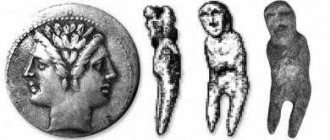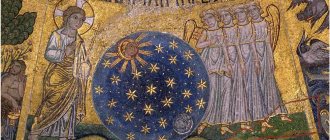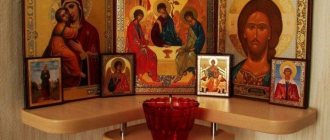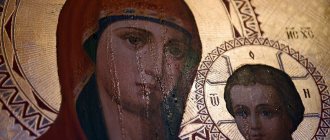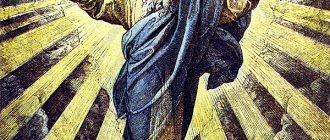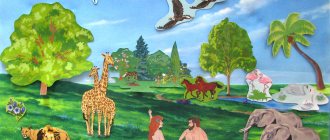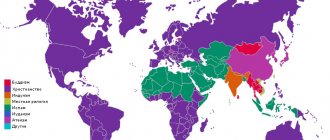The history of the creation of the world has worried people since ancient times. Representatives of different countries and peoples have repeatedly thought about how the world in which they live came into being. Ideas about this have been formed over the centuries, growing from thoughts and guesses into myths about the creation of the world.
That is why the mythology of any people begins with attempts to explain the origins of the surrounding reality. People understood then and understand now that any phenomenon has a beginning and an end; and the logical question of the appearance of everything around logically arose among representatives of Homo Sapiens. The collective consciousness of a group of people in the early stages of development clearly reflected the degree of understanding of a particular phenomenon, including such as the creation of the world and man by higher powers.
People passed on theories of the creation of the world from mouth to mouth, embellishing them, adding more and more details. Basically, myths about the creation of the world show us how diverse the thinking of our ancestors was, because gods, birds, and animals acted as the primary source and creator in their stories. There was, perhaps, one similarity - the world arose from Nothing, from Primordial Chaos. But its further development took place in the way that representatives of one or another people chose for it.
Restoring the picture of the world of ancient peoples in modern times
The rapid development of the world in recent decades has given a chance for a better restoration of the picture of the world of ancient peoples. Scientists of various specialties and directions have been studying found manuscripts, rock paintings, and archaeological artifacts in order to recreate the worldview that was characteristic of the inhabitants of a particular country many thousands of years ago.
Unfortunately, the myths about the creation of the world have not been fully preserved in our time. It is not always possible to reconstruct the original plot of the work from surviving passages, which prompts historians and archaeologists to persistently search for other sources that can fill in the missing gaps.
Nevertheless, from the material that modern generations have at their disposal, a lot of useful information can be extracted, in particular: how they lived, what they believed, who the ancient people worshiped, what is the difference in worldviews among different peoples and what is the purpose of creating the world according to their versions.
Modern technologies provide enormous assistance in searching and recovering information: transistors, computers, lasers, and various highly specialized devices.
The theories of the creation of the world that existed among the ancient inhabitants of our planet allow us to conclude: at the heart of any legend was the understanding of the fact that everything that exists arose from Chaos thanks to something Almighty, Comprehensive, feminine or masculine (depending on the foundations of society).
We will try to briefly outline the most popular versions of the legends of ancient people in order to get a general idea of their worldview.
Disadvantage of the Kant and Laplace hypotheses
The hypotheses of Kant and Laplace, explaining the origin of the planet Earth, were dominant in cosmogony until the beginning of the twentieth century. And they played a progressive role, serving as the basis for the natural sciences, especially geology. The main drawback of the hypothesis is its inability to explain the distribution of angular momentum (MKM) within the Solar System.
The MCR is defined as the product of the mass of a body, the distance from the center of the system and the speed of its rotation. Indeed, based on the fact that the Sun has more than 90% of the total mass of the system, it should also have a high IQR. In fact, the Sun has only 2% of the total ICR, while the planets, especially the giants, are endowed with the remaining 98%.
Theban version of the appearance of the world
The most common (Theban) version tells that from the waters of the endless and bottomless ocean, the very first God, Amun, appeared. He created himself, after which he created other Gods and people.
In later mythology, Amon is already known under the name Amon-Ra or simply Ra (Sun God).
The first people Amon created were Shu, the first air, and Tefnut, the first moisture. From them, God Ra created the Goddess Hathor, who was the Eye of Ra and was supposed to monitor the actions of the Deity. The first tears from the Eye of Ra caused the appearance of people. Since Hathor - the Eye of Ra - was angry with the Deity for existing separately from his body, Amun-Ra placed Hathor on his forehead as a third eye. From his mouth, Ra created other Gods, including his wife, the Goddess Mut, and his son Khonsu, the lunar Deity. Together they represented the Theban Triad of Gods.
Such a legend about the creation of the world makes it clear that the Egyptians laid the Divine principle into the basis of their views on its origin. But this was the supremacy over the world and people not of one God, but of their entire galaxy, which they honored and expressed their respect through numerous sacrifices.
Chaos theory
The Ancient Greeks came closest to a scientific theory. According to their concepts, the birth of the Earth occurred from the primordial Chaos, filled with a mixture of water, earth, fire and air. This fits with the scientific postulates of the theory of the origin of the Earth. An explosive mixture of elements rotated chaotically, filling everything that existed. But at some point, from the depths of the primordial Chaos, the Earth was born - the goddess Gaia, and her eternal companion, Sky, - the god Uranus. Together, they filled the lifeless spaces with a variety of life.
A similar myth has formed in China. Chaos Hun-tun, filled with the five elements - wood, metal, earth, fire and water - circled in the shape of an egg throughout the boundless Universe until the god Pan-Gu was born in it. When he woke up, he found only lifeless darkness around him. And this fact saddened him greatly. Having gathered his strength, the deity Pan-Gu broke the shell of the chaos egg, releasing two principles: Yin and Yang. Heavy Yin sank down, forming the earth, light and light Yang soared up, forming the sky.
Matriarchal and patriarchal versions of the emergence of the world
For example, according to one of the matriarchal myths, the ancestor of the world was Gaia - Mother Earth, who arose from Chaos and gave birth to the God of Heaven - Uranus. The son, in gratitude to his mother for his appearance, poured rain on her, fertilizing the earth and awakening the seeds dormant in it to life.
The patriarchal version is more expanded and deeper: in the beginning there was only Chaos - dark and boundless. He gave birth to the Goddess of the Earth - Gaia, from whom all living things came, and the God of Love Eros, who breathed life into everything around.
In contrast to the living and striving for the sun, the gloomy and gloomy Tartarus was born underground - a dark abyss. Eternal Darkness and Dark Night also arose. They gave birth to Eternal Light and Bright Day. Since then, Day and Night have replaced each other.
Then other creatures and phenomena appeared: Deities, titans, cyclops, giants, winds and stars. As a result of a long struggle between the Gods, Zeus, the son of Kronos, raised by his mother in a cave and overthrew his father from the throne, stood at the head of Heavenly Olympus. Starting with Zeus, other famous Greek Gods, considered the ancestors of people and their patrons, take their history: Hera, Hestia, Poseidon, Aphrodite, Athena, Hephaestus, Hermes and others.
People revered the Gods and propitiated them in every possible way, building luxurious temples and bringing countless rich gifts to them. But in addition to the Divine creatures living on Olympus, there were also such respected creatures as: Nereids - sea inhabitants, Naiads - guardians of reservoirs, Satyrs and Dryads - forest talismans.
According to the beliefs of the ancient Greeks, the fate of all people was in the hands of three goddesses, whose name was Moira. They spun the thread of each person's life: from the day of birth to the day of death, deciding when this life would end.
Myths about the creation of the world are replete with numerous incredible descriptions, because, believing in forces higher than man, people embellished them and their deeds, endowing them with superpowers and the ability inherent only to gods to rule the fate of the world and man in particular.
With the development of Greek civilization, myths about each of the deities became increasingly popular. A great many of them were created. The worldview of the ancient Greeks significantly influenced the development of the history of the state that emerged at a later time, becoming the basis of its culture and traditions.
Zervanist cosmogonic myth (III - IV centuries AD)
The religious and philosophical movement of Zervanism arose in the 3rd - 4th centuries during the Sassanid dynasty, as an attempt to interpret the “Doctrine of Dualism”, the 30th century. Some researchers attribute the cult of Zervan, the primordial uncreated god; the emergence of Zervanism dates back to the time of the Achaemenids (6th–4th centuries BC), to the end of the 8th century or in the first half of the 7th century. BC, when it arose in the priestly environment of the magicians of Media and even to the period of the existence of ancient Iranian cults, since the myths about twins are among the earliest in human history. The later time of writing the myth is evidenced by the original idea about the necessity, benefit and effectiveness of sacrifices, which could have been introduced by the priests. The Avesta is silent about the origin of Ahura Mazda and his counterpart-antagonist Angra Manyu. In the cosmogonic myth of Zervanism, the root cause of all things was Zervan, the god of endless time and space, eternity and fate. According to followers of Zervanism, Zervan is eternal time in which God created himself. According to the Zervanites, Zervan gave birth to two twin brothers, Ahura Mazda and Angra Manya, who embodied the principles of creation and destruction. The myth of Zervan came to us in the retelling of two Armenian (Yegishe Vardapet (410-475) and Eznik Koghbatsi (380-450) and two Syrian authors. When nothing existed, neither heaven nor earth, there was only the great god Zurvan, whose name means "fate" or "fortune". He makes sacrifices for a thousand years so that he will have a son who will be called Ohrmazd and who will create heaven and earth. At the end of this period, which lasted a thousand years, he began to think: "What is the meaning of these sacrifices that I made? Will I really have a son named Ohrmazd? Or is it all in vain?" And before this thought had time to arise, Ohrmazd and Ahriman were conceived in him: Ohrmazd - as a result of the sacrifices made, and Ahriman - from -for his doubts. When he realized that there were two sons in his womb, he swore: “Whichever of the two sons appears first will be proclaimed by me as god.” Ohrmazd recognized the thoughts of his father and told them to Ahriman. When Ahriman heard this, he tore his womb, came out and approached his father. Zurvan, seeing him, asked: “Who are you?” And he answered: “I am your son Ohrmazd.” And Zurvan said: “My son is bright and fragrant, and you are dark and fetid.” He cried bitterly. And they began to talk when Ohrmazd was born, bright and fragrant. Zurvan, seeing him, realized that it was his son Ormazd, for whom he made his sacrifice. During the conversation, he held in his hands the twigs of the leopard, which he sacrificed. He gave them to Ohrmazd with the words: “Until this moment, it was I who made the sacrifice in your name, from now on you must make the sacrifice in my name.” But even when Zurvan handed over the sacrificial branches to Ohrmazd, Ahriman came close to him and said: “Didn’t you swear that you would proclaim as god the son who would appear first?” And Zurvan said to him: “Oh, unclean one, the kingdom will be given to you for nine thousand years, but I have already made Ohrmazd a god over you, and after nine thousand years he will rule and do as he pleases.” And Ohrmazd created the heavens and the earth, everything beautiful and good, and Ahriman - the demons and everything evil and wrong. Ohrmazd created wealth, Ahriman created poverty. (according to R. Ch. Zener “Zurvanism”). The Zervanite myth was also preserved in the presentation of Mihr-Narseh (5th century), a Persian commander who sent a detailed presentation of the Zoroaster religion to the Armenian bishops and princes, convincing them to accept it. The message said: When heaven and earth did not yet exist, Zervan, the great god, made sacrifices for a thousand years, saying: perhaps a son will be born to me, named Ohrmazd, who will create heaven and earth. Two were conceived in his womb, one for an offering, the other for a word: perhaps. When he learned that there were two in his womb, he said: the one who is born first will receive my kingdom. Conceived from doubt, he burst through his womb and came out into the world. Who are you? - Zervan asked him. Your son is Ohrmazd, he answered. No! My son is radiant and fragrant, Zervan objected; you are gloomy and angry. But when he cried bitterly, Zervan gave him the kingdom for a while. Then he gave birth to another son, whom he named Ohrmazd, took the kingdom from Ahriman and gave it to Ohrmazd, saying to him: “Until now I have made offerings to you, now you bring them to me.” Then Ohrmazd created heaven and earth; Ahriman, on the contrary, created evil. Thus, all creations were divided: the angels of Ohrmazd, and the devas - of Ahriman. All blessings that descend from heaven to earth are the works of Ohrmazd; and Ahriman created all the misfortunes that happen here and there. Ohrmazd created everything good on earth, and Ahriman created everything bad; Thus, Ohrmazd created man, and Ahriman created sorrow, illness and death. Misfortunes, defeats and disastrous wars are the creations of the evil principle; but prosperity, power, fame, honor, bodily health, facial beauty, eloquence, longevity, derive their existence from good.”
The emergence of the world through the eyes of ancient Indians
In the context of the topic “Myths about the creation of the world,” India is known for several versions of the appearance of everything on Earth.
The most famous of them is similar to Greek legends, because it also tells that in the beginning the impenetrable darkness of Chaos dominated the Earth. She was motionless, but full of hidden potential and great power. Later, Water appeared from Chaos, which gave birth to Fire. Thanks to the great power of heat, a Golden Egg appeared in the Waters. At that time, there were no celestial bodies or time measurements in the world. However, according to the modern account of time, the Golden Egg floated in the vast waters of the ocean for about a year, after which the progenitor of everything named Brahma arose. He broke the egg, as a result of which its upper part turned into Heaven, and its lower part into Earth. An air space was placed between them by Brahma.
Next, the progenitor created the countries of the world and began the countdown of time. Thus, according to Indian legend, the Universe came into being. However, Brahma felt very lonely and came to the conclusion that living beings must be created. The power of Brahma's thought was so great that with its help he was able to create six sons - great lords, and other goddesses and gods. Tired of such global affairs, Brahma transferred power over everything existing in the Universe to his sons, and he himself retired.
As for the appearance of people in the world, according to the Indian version, they were born from the goddess Saranyu and the god Vivasvat (who turned from God into man by the will of the elder gods). The first children of these gods were mortals, and the rest were gods. Yama was the first of the mortal children of the gods to die, and in the afterlife he became the ruler of the kingdom of the dead. Another mortal child of Brahma, Manu, survived the Great Flood. From this god people originated.
"War of the Gods" in Aztec legends
Once upon a time, the deity Ometeotl arose in the 13th sky. The 4 gods who appeared first after him were also the strongest. It was they who created earth and water, fire, as well as the calendar. Red Tezcatlipoca became the Sun, and the other gods made giants. Then the Sun did not move across the sky and quickly darkened. Then Quetzalcoatl hit this god with his staff, he flew into the water, became a huge tiger and ate everyone. Quetzalcoatl himself became a luminary, people appeared again. But Tezcatlipoca destroyed the Sun. The wind took everything away, almost all the people died, and the rest became monkeys. Then Tlaloca was the Sun, but ice and fire fell from the sky. Almost all the people died, and the survivors became birds. Later, Chalchihuitlicue was the Sun, heavy rains began, and there was a flood. The people who survived turned into fish. Soon the gods created new people.
Pirushi - The First Man on Earth
Another legend about the creation of the world tells of the appearance of the First Man, called Pirusha (in other sources - Purusha). This myth is characteristic of the Brahmanical period. Purusha was born thanks to the will of the Almighty Gods. However, later Pirushi sacrificed himself to the Gods who created him: the body of the primordial man was cut into parts, from which the heavenly bodies (Sun, Moon and stars), the sky itself, the Earth, the countries of the world and classes of human society emerged.
The Brahmans, who arose from the mouth of Purusha, were considered the highest class - caste. They were the priests of the gods on earth; knew the sacred texts. The next most important class were the Kshatriyas - rulers and warriors. The Primordial Man created them from his shoulders. From the thighs of Purusha appeared traders and farmers - Vaishyas. The lowest class that emerged from the feet of Pirusha were the Shudras - forced people who played the role of servants. The most unenviable position was occupied by the so-called untouchables - you could not even touch them, otherwise a person from another caste would immediately become one of the untouchables. Brahmins, kshatriyas and vaishyas, upon reaching a certain age, were initiated and became “twice-born”. Their life was divided into certain stages:
- Apprenticeship (a person learns life from wiser adults and gains life experience).
- Family (a person creates a family and is obliged to become a decent family man and housewife).
- Hermit (a person leaves home and lives the life of a hermit monk, dying alone).
Brahmanism assumed the existence of such concepts as Brahman - the basis of the world, its cause and essence, the impersonal Absolute, and Atman - the spiritual principle of each person, inherent only to him and striving to merge with Brahman.
With the development of Brahmanism, the idea of Samsara—the cycle of existence—emerges; Incarnations are rebirths after death; Karma - fate, the law that will determine what body a person will be born in in the next life; Moksha is the ideal to which the human soul needs to strive.
Speaking about the division of people into castes, it is worth noting that they should not have had contact with each other. Simply put, each class of society was isolated from the other. The too strict caste division explains the fact that only brahmins, representatives of the highest caste, could deal with mystical and religious problems.
However, later more democratic religious teachings emerged - Buddhism and Jainism, which took a point of view opposing the official teaching. Jainism became a very influential religion within the country, but remained within its borders, while Buddhism became a world religion with millions of followers.
Despite the fact that the theories of the creation of the world through the eyes of the same people differ, in general they have a common principle - the presence in any legend of a certain First Man - Brahma, who eventually became the main deity believed in in Ancient India.
The emergence of Zoroastrianism
Around the 6th century. BC e., and according to some data in the X - VI centuries. BC uh, the prophet Zoroaster (Zarathustra, Zoroaster) founded the new religion of Zoroastrianism, setting out its main provisions in the Avesta, the book of “Holy Scriptures”. At the same time, the Avesta contained the revelations of Zoroaster, recorded in the form of poetic hymns of the Gathas, as well as mythological stories of the ancient Iranian religion of the 2nd and early 1st millennium BC, transmitted orally. e. The Avesta contains three parts: 1. Yasna (17 Gat). 2. Yashty (22 hymns in honor of the lower gods). 3. Videvdat, a later generalization of various legends and cosmological myths. The main provisions of the teachings of Zoroaster (Zaratushtra) were later developed and summarized in the form of a code called the Small (Younger) Avesta, dating back to the Achaemenid era (VI-IV centuries BC). Adjacent to the Avesta is its interpretation of Zend (IV–VI centuries AD), written down in the Pahlavi (Middle Persian) language, but also a number of works that continue the traditions of Zoroastrianism, in particular a collection of texts about the creation of the world “Bundahishn” (Universe) or “Creation foundations" (III – VII centuries AD)
Cosmogony of Ancient India
The latest version of the cosmogony of Ancient India sees in the foundation of the world a triad of Gods (the so-called Trimurti), which included Brahma the Creator, Vishnu the Guardian, and Shiva the Destroyer. Their responsibilities were clearly distributed and delineated. Thus, Brahma cyclically gives birth to the Universe, which is preserved by Vishnu, and destroys Shiva. As long as the Universe exists, Brahma's day lasts. As soon as the Universe ceases to exist, the night of Brahma begins. 12 thousand Divine years - this is the cyclic duration of both day and night. These years consist of days, which are equal to the human concept of a year. After Brahma's hundred-year life, he is replaced by a new Brahma.
In general, the cult significance of Brahma is secondary. Evidence of this is the existence of only two temples in his honor. Shiva and Vishnu, on the contrary, gained wide popularity, transforming into two powerful religious movements - Shaivism and Vaishnavism.
Fesenkov's theory
In 1960, the Soviet scientist Fesenkov tried to explain this contradiction. According to his version of the origin of the Earth, the Sun and the planets were formed as a result of the compaction of a giant nebula - a “globule”. The nebula had very rarefied matter, composed mainly of hydrogen, helium and a small amount of heavy elements. Under the influence of gravity, a star-shaped condensation - the Sun - arose in the central part of the globule. It was spinning quickly. As a result of the evolution of solar matter, matter was ejected from time to time into the surrounding gas and dust environment. This led to the Sun losing its mass and transferring a significant part of the MCR to the created planets. The formation of planets took place through the accretion of nebula matter.
Creation of the world according to the Bible
The history of the creation of the world according to the Bible is also very interesting from the point of view of theories about the creation of all things. The Holy Book of Christians and Jews explains the origin of the world in its own way.
The creation of the world by God is illuminated in the first book of the Bible - Genesis. Just like other myths, the legend tells that in the very beginning there was nothing, not even the Earth. There was only complete darkness, emptiness and cold. All this was observed by Almighty God, who decided to revive the world. He began his work by creating the earth and sky, which did not have any definite shapes or outlines. After this, the Almighty created light and darkness, separating them from each other and calling them day and night, respectively. This happened on the first day of the universe.
On the second day, God created a firmament, which divided the water into two parts: one part remained above the firmament, and the second below it. The name of the firmament became Sky.
The third day was marked by the creation of land, which God called Earth. To do this, he collected all the water that was under the sky in one place and called it the sea. To revive what had already been created, God created trees and grass.
The fourth day became the day of the creation of the luminaries. God created them to separate day from night, and also so that they always illuminate the earth. Thanks to the luminaries, it became possible to count days, months and years. During the day, a large luminary, the Sun, shone, and at night, a smaller luminary, the Moon, shone (he was helped by the stars).
The fifth day was dedicated to the creation of living beings. The very first to appear were fish, aquatic animals and birds. God liked what was created, and he decided to increase their number.
On the sixth day, creatures that lived on land were created: wild animals, cattle, snakes. Since God still had a lot of things to do, he created an assistant for himself, calling him Man and making him like himself. Man was to become the ruler of the earth and everything that lives and grows on it, while God reserved for himself the privilege of ruling the whole world.
A man emerged from the dust of the earth. To be more precise, he was sculpted from clay and named Adam (“man”). God settled him in Eden - a paradise country through which a mighty river flowed, overgrown with trees with large and tasty fruits.
In the middle of paradise, two special trees stood out - the tree of the knowledge of good and evil and the tree of life. Adam was tasked with guarding and tending the Garden of Eden. He could eat from any tree except the tree of the knowledge of good and evil. God threatened him that, having eaten the fruit from this particular tree, Adam would immediately die.
Adam was bored alone in the garden, and then God ordered all living creatures to come to man. Adam gave names to all the birds, fish, reptiles and animals, but did not find anyone who could become a worthy helper for him. Then God, taking pity on Adam, put him to sleep, took a rib out of his body and created a woman out of it. Waking up, Adam was delighted with such a gift, deciding that the woman would become his faithful companion, assistant and wife.
God gave them parting instructions - to fill the earth, to possess it, to have dominion over the fish of the sea, the birds of the air and other animals that walk and crawl on the earth. And he himself, tired from the work and satisfied with everything created, decided to rest. Since then, every seventh day has been considered a holiday.
This is how Christians and Jews imagined the creation of the world day by day. This phenomenon is the main dogma of the religion of these peoples.
Laplace's concept
The French astronomer and mathematician P. Laplace proposed a somewhat different option explaining the origin of planet Earth and other planets. The solar system, in his opinion, was formed from a hot gas nebula with a bunch of particles in the center. It rotated and contracted under the influence of universal gravity. With further cooling, the rotation speed of the nebula increased, rings peeled off along its periphery, which disintegrated into prototypes of future planets. At the initial stage, the latter were hot balls of gas, which gradually cooled and solidified.
Myths about the creation of the world of different nations
In many ways, the history of human society is, first of all, a search for answers to fundamental questions: what happened in the beginning; what is the purpose of creating the world; who is its creator. Based on the worldviews of peoples who lived in different eras and under different conditions, the answers to these questions acquired an individual interpretation for each society, which in general terms could come into contact with the interpretations of the emergence of the world among neighboring peoples.
Nevertheless, each nation believed in its own version, revered its god or gods, and tried to spread its teachings and religion regarding such an issue as the creation of the world among representatives of other societies and countries. The passage of several stages in this process became an integral part of the legends of ancient people. They firmly believed that everything in the world arose gradually, one by one. Among the myths of different peoples, there is not a single story where everything that exists on earth appears in an instant.
Ancient people identified the birth and development of the world with the birth of a person and his maturation: first, a person is born into the world, acquiring more and more new knowledge and experience every day; then there is a period of formation and maturation, when the acquired knowledge becomes applicable in everyday life; and then comes the stage of aging, extinction, which involves a person’s gradual loss of vitality, which ultimately leads to death. The same stages in the views of our ancestors applied to the world: the emergence of all living things thanks to one or another higher power, development and flourishing, extinction.
Myths and legends that have survived to this day form an important part of the history of the development of a people, allowing us to associate our origins with certain events and gain an understanding of where it all began.
Kant's hypothesis
In 1755, the German philosopher Kant briefly described the origin of the Earth as follows: the original Universe consisted of stationary dust particles of varying densities. The forces of gravity caused their movement. They stuck to each other (accretion effect), which ultimately led to the formation of a central hot clump - the Sun. Further collisions of particles led to the rotation of the Sun, and with it the dust cloud.
In the latter, separate clumps of matter gradually formed - the embryos of future planets, around which satellites were formed according to a similar pattern. The Earth formed in this way at the beginning of its existence seemed cold.
Conclusion
A lot of popular science literature, children's books, and specialized publications have been published on the topic of the formation of the Solar System. The origin of the Earth for children is presented in an accessible form in school textbooks. But if we take the literature from 50 years ago, it is clear that modern scientists look at some problems differently. Cosmology, geology and related sciences do not stand still. Thanks to the conquest of near-Earth space, people already know how planet Earth appears in the photo from space. New knowledge forms a new understanding of the laws of the Universe.
It is obvious that powerful forces of nature were used to create the Earth, planets and the Sun from the primordial chaos. It is not surprising that the ancient ancestors compared them with the accomplishments of the Gods. Even figuratively it is impossible to imagine the origin of the Earth; pictures of reality would certainly surpass the wildest fantasies. But based on the grains of knowledge collected by scientists, a holistic picture of the world around us is gradually being built.
Schmidt's hypothesis
In matters of the theory of the origin of the Earth, Schmidt expressed an original point of view in 1944. This is the so-called meteorite hypothesis, which was subsequently physically and mathematically substantiated by the students of the famous scientist. By the way, the hypothesis does not consider the problem of the formation of the Sun.
According to the theory, the Sun, at one of the stages of its development, captured (pulled towards itself) a cold gas-dust meteorite cloud. Before this, it had a very small MCR, and the cloud rotated at a significant speed. In the strong gravitational field of the Sun, differentiation of the meteorite cloud began in terms of mass, density and size. Some of the meteorite material fell on the star, while others, as a result of accretion processes, formed clumps-embryos of planets and their satellites.
In this hypothesis, the origin and development of the Earth depends on the influence of the “solar wind” - the pressure of solar radiation, which pushed light gas components to the periphery of the Solar system. The Earth formed in this way was a cold body. Further heating is associated with radiogenic heat, gravitational differentiation and other sources of internal energy of the planet. The researchers consider the big drawback of the hypothesis to be the very low probability of such a meteorite cloud being captured by the Sun.
Formation of the earth's crust
The origin and development of the Earth is inextricably linked with mountain formation. A. Wegener argued that continents consisting of fairly light mineral masses seem to float on the underlying heavy plastic substance of the basalt bed. It is assumed that in the beginning a thin layer of granite material allegedly covered the entire Earth. Gradually, its integrity was disrupted by the tidal forces of attraction of the Moon and the Sun, acting on the surface of the planet from east to west, as well as centrifugal forces from the rotation of the Earth, acting from the poles to the equator.
The single supercontinent Pangea (presumably) consisted of granite. It existed until the middle of the Mesozoic era and collapsed in the Jurassic period. A proponent of this hypothesis of the origin of the Earth was the scientist Staub. Then a union of continents of the northern hemisphere arose - Laurasia, and a union of continents of the southern hemisphere - Gondwana. Sandwiched between them were the rocks of the Pacific Ocean floor. Beneath the continents lay a sea of magma along which they moved. Laurasia and Gondwana rhythmically moved either to the equator or to the poles. When moving toward the equator, the supercontinents compressed frontally, while pressing on the Pacific mass with their flanks. These geological processes are considered by many to be the main factors in the formation of large mountain ranges. Movement towards the equator occurred three times: during the Caledonian, Hercynian and Alpine orogenies.
Continental drift
At the beginning of the twentieth century. the hypothesis of continental drift is emerging. Scientists have long noticed the similarity of the coastlines of South America and Africa, Africa and the Arabian Peninsula, Africa and Hindustan, etc. Pilligrini (1858) was the first to compare the data, later Bikhanov. The very idea of continental drift was formulated by the American geologists Taylor and Baker (1910) and the German meteorologist and geophysicist Wegener (1912). The latter substantiated this hypothesis in his monograph “The Origin of Continents and Oceans,” which was published in 1915. Arguments given in defense of this hypothesis:
- The similarity of the outlines of the continents on both sides of the Atlantic, as well as the continents bordering the Indian Ocean.
- Similarity of the structure of geological sections of late Paleozoic and early Mesozoic rocks on adjacent continents.
- Fossilized remains of animals and plants, which indicate that the ancient flora and fauna of the southern continents formed a single group: this is especially evidenced by the fossilized remains of dinosaurs of the genus Lystrosaurus, found in Africa, India and Antarctica.
- Paleoclimatic data: for example, the presence of traces of Late Paleozoic glaciation.
